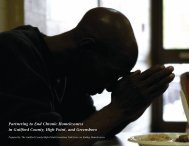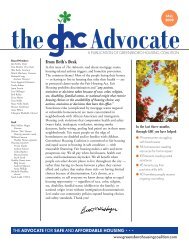data - Greensboro Housing Coalition
data - Greensboro Housing Coalition
data - Greensboro Housing Coalition
You also want an ePaper? Increase the reach of your titles
YUMPU automatically turns print PDFs into web optimized ePapers that Google loves.
percent in 2007 to 14.4 percent in 2008. Chapter 4 explores trends in sheltered homelessness<br />
among individuals and persons in families in greater detail.<br />
The share of sheltered homeless people who are<br />
Although national individuals or persons in families differs between the<br />
estimates of the sheltered one-day count and the count over the course of a year<br />
homeless population show (see Exhibit 2-10). In 2008, about 338,900 people<br />
were in an emergency shelter or a transitional<br />
little change since 2007,<br />
housing program on an average day, about 21 percent<br />
homelessness increased by<br />
of the total annual estimate. On an average night,<br />
9 percent among persons individuals represented 57 percent of the sheltered<br />
in families.<br />
population, and persons in families represented 43<br />
percent. 9 However, the one-day estimates of the split<br />
between individuals and family members were very different from the one-year-estimates,<br />
which show that individuals comprised about 68 percent of people in shelters at some time<br />
during the year were individuals and only 32 percent were persons in families.<br />
Exhibit 2-10: Difference in Share of Sheltered Homeless Individuals and<br />
Persons in Families Between Average Night and Annual<br />
Estimates, 2008<br />
Average Night Estimate (N=338,910)<br />
One-Year Estimate (N=1,593,794)<br />
43.1%<br />
56.9%<br />
Individuals<br />
Persons in<br />
Families<br />
32.4%<br />
68.6%<br />
Individuals<br />
Persons in<br />
Families<br />
Source: Homeless Management Information System <strong>data</strong>, 2008<br />
The larger share of persons in families on an average day compared to a longer period is a<br />
pattern that has been observed in previous Annual Homeless Assessment Reports. The<br />
pattern highlights how individuals and persons in families use shelter differently. Families<br />
stay in shelters for longer periods than individuals. As a result, persons in families are more<br />
9<br />
The HMIS-based estimate for an average day between October 2007 and September 2008 was only slightly<br />
lower than the PIT estimate for a particular day in January 2008: about 386,400 people, of whom 53<br />
percent were individuals and 47 percent persons in families.<br />
20 Chapter 2: National Estimates of All Homeless People, Sheltered and Unsheltered




